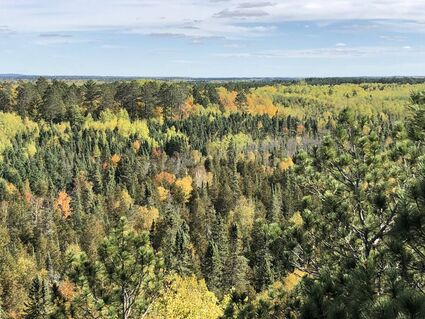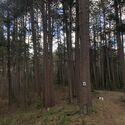Winds of change blow over forestry center
April 15, 2022

Jana Peterson
Discussion about the future ownership of the Cloquet Forestry Center continue, albeit in no public way. The Fond du Lac Band of Lake Superior Chippewa has indicated that it would like the land within its reservation lands returned after the center was founded in 1909.
A few miles west of Cloquet, in the heart of the Fond du Lac Reservation, sits the Cloquet Forestry Center. Owned by the University of Minnesota, the woodland site has been the primary research and education forest for the university since 1909. It is the oldest experimental forest under continuous operation by a university in the United States, according to Al Alm, professor emeritus and former CFC director.
That could change in the not so distant future, as university officials have been discussing potential changes at the forestry center, part of an ongoing conversation with the Fond du Lac Band of Lake Superior Chippewa.
Details of those conversations are not readily available. There are no posted public meetings. It's more of an ongoing discussion, according to Jake Ricker, public relations director for the University of Minnesota.
"At this point, these discussions are more about information gathering and sharing perspectives and histories. They are not focused on a specific outcome," Ricker said.
He responded to questions from the Pine Knot News directed at various officials believed to be participating in the discussions, including University of Minnesota president Joan Gabel, Brian Buhr, dean of the College of Food, Agricultural and Natural Resource Sciences, and Karen Diver, former chairwoman of the Fond du Lac Band of Lake Superior Chippewa and now senior advisor to the university president for Native American affairs. He did not confirm that he spoke to anyone with the exception of Diver.
Current forestry center director Andrew David referred questions to the university's communications department, and Fond du Lac spokeswoman Rita Karppinen did not respond to questions emailed by the Pine Knot News before deadline. Reservation Business Committee chairperson Kevin Dupuis spoke with the Minneapolis Star Tribune last year, sharing his thoughts on the forestry center land.
In that April 3, 2021, story, headlined "Land seizures, 'unethical' research: University of Minnesota confronts troubled history with tribal nations," Dupuis said the band wants the forestry center land back, to use as it desires. He said the band wants to use it for "natural reasons," not for research that was not historically shared or explained to the tribe.
When asked about rumors that the discussion group is considering three options for the future of the forestry center - no change, giving the lands to the Fond du Lac Band, or joint management with the Band - Ricker said discussions aren't focused on a specific outcome or timeline. The topics currently being discussed are expansive, he said.
"This list isn't necessarily exhaustive but we have been sharing more information about the research being conducted at the Cloquet Forestry Center and how these research efforts may (currently or in the future) align with the research needs of the Band, program development and community engagement, the history of the property and cultural uses, and the potential return of some lands to the Band," Ricker said.
Al Alm, who worked at the forestry center on and off for nearly 30 years before retiring in 1992, is worried that the forestry center will cease to exist, and is upset about the lack of transparency regarding the discussions.
In a letter to Gabel that he shared with the Pine Knot, Alm urged the university president to keep the forestry center under university management and operation "so it can continue as a national leader in forest research and education."
Land issues
Fond du Lac chairperson Kevin Dupuis has a point regarding the forestry center property. It was originally part of the lands set aside by the federal government for the Fond du Lac Reservation.
As a result of local and statewide efforts to create a research forest, in 1909 the United States Secretary of the Interior of the United States was authorized by Congress to convey 2,200 acres of reservation land at $1.25 an acre to the state of Minnesota for use as a demonstration and experiment forest. At the same time, the Secretary of the Interior removed restrictions on adjoining allotments so they could be sold by their Native American owners to the state.
According to a forestry center history (at cfc.cfans.umn.edu/about/history), the initial block of 2,215 acres was paid for by the St. Louis River Mercantile Company at $1.25 per acre with the understanding that while the title to the land would go to the University of Minnesota, the timber rights would be retained by the company. The lumber companies were reimbursed by the university for the price that was paid to the reservation for that timber.
More acres were purchased from Indian allotments made possible, in part, through the Dawes Act (1887) and Nelson Act (1889), and paid for with funding granted by the state legislature.
According to a National Park Service page on Native Americans and the Homestead Act, Native American lands decreased significantly under the Dawes Act. Nationally, reservation lands went from 138 million acres in 1887 to 48 million acres in 1934, a loss of 65 percent, before the Dawes Act was repealed.
Although the land purchases were technically legal, it was certainly part of historical U.S. government actions that took lands allocated to tribes for other uses.
Unique resource
The Cloquet Forestry Center has been a working branch of the University of Minnesota since 1910, going on 112 years.
Within the center boundaries is a 44-acre stand of trees called "Camp 8" that dates back to the 1820s, with a few other "parent trees" mixed in that date back as far as the 1770s. There is an arboretum that has existed since the 1920s, containing tree species from around the country and the world, providing a long look at how other species may survive here. Every year local elementary school and high school students visit the forestry center for educational field trips and competitions, and university students studying forestry come for field work.
Alm talks about studies using 100 years of measurements and observations that could never be repeated if they are lost, of vital research about the ruffed grouse that was conducted there, climate change studies and more. His own studies on containerized seedlings changed the way seedlings are grown today: mostly in greenhouses rather than across acres and acres of land, extending the growing season and reducing the amount of land needed. "If you can grow 11 million trees in 5 acres of greenhouse instead of 200 acres of land, that's much more efficient," he said.
From the beginning, the forestry center existed for research, but that research also benefited local wood industries, like the sawmills and paper mills in Cloquet.
Over the past 110 years, there have been studies on tree growth, tree harvesting, regeneration, forest ecology, wildlife (ruffed grouse and woodcock in particular) and forest pathology. More studies are ongoing, carried out by forestry staff or University of Minnesota students.
Alm said more than 1,000 publications have resulted from research conducted at the forestry center.
According to the history, the primary intent for establishing a research forest was to develop methods for the reforestation of cut-over lands and the long-term demonstration of silvicultural principles. The United States Forest Service defines silviculture as "the art and science of controlling the establishment, growth, composition, health, and quality of forests and woodlands to meet the diverse needs and values of landowners and society such as wildlife habitat, timber, water resources, restoration, and recreation on a sustainable basis."
Community
The Cloquet Forestry Center is also open to the public and is used by as a place to walk, run, bike, cross country ski or snowshoe and just enjoy nature.
Visitors are asked to keep dogs leashed and to not use motorized vehicles. Horseback riding, once frequent, is not allowed now, in part because horse waste can introduce invasive species. Hunting is not allowed.
It's generally a quiet place, unless you happen to arrive on a day when the Scouts are doing wilderness survival activities or hordes of fifth-graders are learning about dead trees and their importance as habitat.
"The old-growth trees are also wonderful for scenic visitation," Alm said, recalling the days when area residents would picnic there every weekend, when picnics were a popular pastime. "Just to see these big old trees, what old forest feels like, it's pretty special."
Ongoing talks
Gabel has made improving relationships with Minnesota's 11 tribal nations a priority for her administration. Discussions between the Band and University staff are expected to continue through the spring and summer, Ricker said.
There could be opportunity for input from the public and other stakeholders down the road, but the goal for now is to provide the Band with the opportunity to engage at the same level the university has afforded other stakeholders in the past, he said.
Ricker stressed again that the conversations about the forestry center are not being held with a specific goal in mind.
"It would be premature and irresponsible to speculate on the outcome of these conversations at this time, but they have been productive to the relationship between the University and the Band," he said, promising updates down the road.
The lack of any real information about the actual discussions makes Alm a little angry. "At my age I don't care whose toes I step on," he said. "What's the big secret? Why is there no transparency?"








